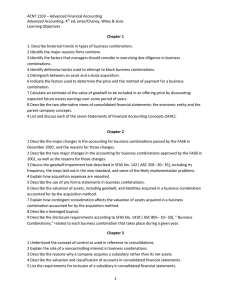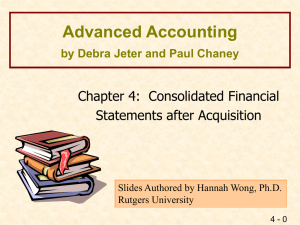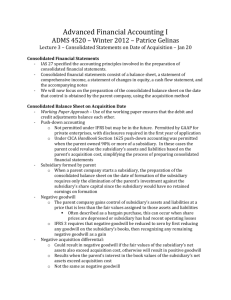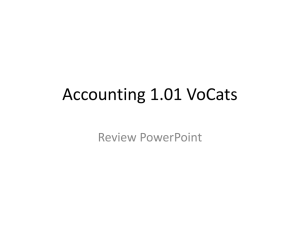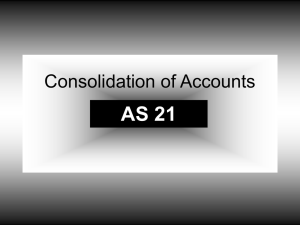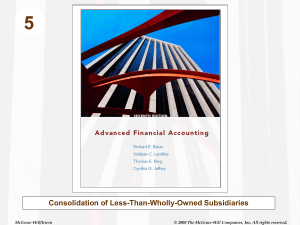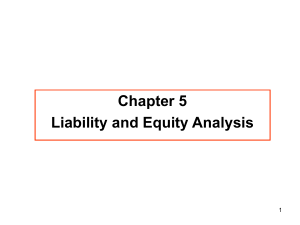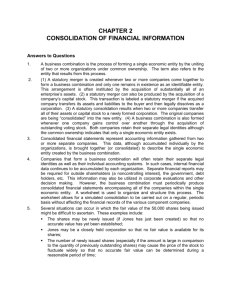Chapter 4 Consolidated financial statements—date of acquisition
advertisement
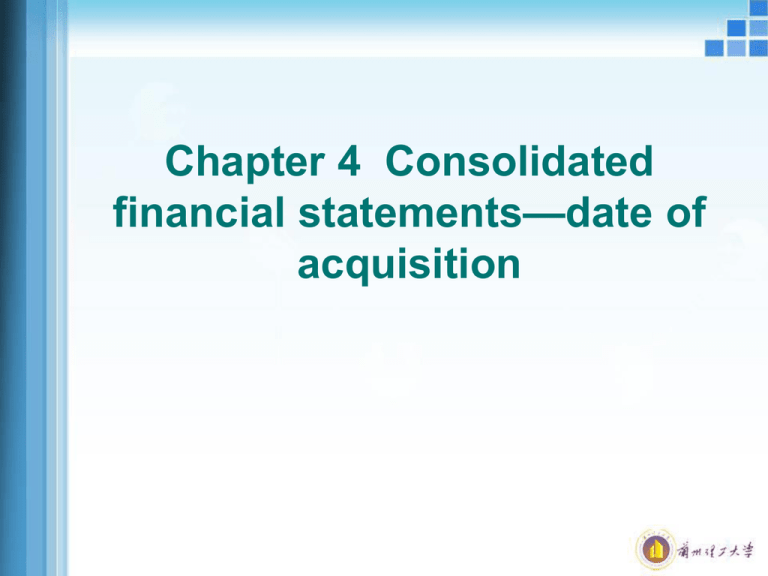
Chapter 4 Consolidated financial statements—date of acquisition Terminology Asset acquisition Stock acquisition Parent Subsidiary Non-controlling (minority )interest Affiliation Affiliated company Consolidated financial statements Definition of subsidiary and control Own a controlling interest in the voting shares ,often more than 50%, directly or indirectly or both Control the operation policies and management rather than asset Have effective control despite a smaller percentage ownership The range of companies consolidated Essentially all controlled corporations should be consolidated Under below circumstances ,majority-owned subsidiaries should be excluded: ownership is temporary; control does not rest with majority owner ; exposed to foreign exchange restriction etc. Consolidated financial statements Necessity: unconsolidated financial statements of parent company are insufficient to present the financial position and results of operations of the economic unit controlled by the parent company . Consolidated financial statements include the full complement of statements normally prepared for a separate entity and represent essentially the sum of the assets , liabilities , revenues and expenses of the affiliates after eliminating the effect of any transactions among the affiliated companies( intercompany transactions ) The purpose of consolidated statements is to present ,primarily for the benefit of the stockholders and creditors of the parent company ,the results of operations and the financial position of a parent company and its subsidiaries essentially as if the group were a single company with one or more branches or divisions. Focus on substance rather than form They are not substitutes for the statements of separate subsidiary Investment at the date of acquisition Purchase method Asset acquisition Pooling method Business combination Purchase method Stock acquisition Pooling method Recording investments at cost (p company ) Investment in s company 260,000 cash 260,000 (250,000+10,000) investment in s company 133,000 cash 133,000 (125,000+8,000) investment in s company 260,000 common stock 200,000 other contributed capital 60,000 investment in s company (finder’s fee) 10,000 cash 10,000 Intercompany accounts to be eliminated Parent’s account Investment in subsidiary Subsidiary’ s account against Equity accounts Intercompany receivable (payable) against Intercompany payable (receivable) Advances to subsidiary (from it) against Advances to parent (from it) Interest revenue (interest expense) against Interest expense (interest revenue) Dividend revenue (Dividends declared) against Dividend declared (Dividends revenue) Management fees received from subsidiary against Management fee paid to parent Sales to subsidiary (purchase of inventory from subsidiary ) against purchase of inventory from parent (Sales to parent) Difference between cost and book value CAD schedule Determine the percentage of acqisition:100% acquisition or a smaller percetage Compare the purchase price (cost )to the book value of the equity acquired Allocate the difference to adjust the underlying assets and /or liabilities CAD leads to the following possible cases Case 1. cost =the book value (of equity acquired) (a)100% acquisition (b) a smaller percentage acquisition Case 2. cost >the book value (of equity acquired) (a)100% acquisition (b) a smaller percentage acquisition Case 3. cost <the book value (of equity acquired) (a)100% acquisition (b) a smaller percentage acquisition consolidated balance sheet P company Cash Other current assets Plant and equipment Land Investment in S company Total assets Liabilities Common stock P company S company Other contributed capital P company S company Retained earning P company S company Total liabilities and equity S compan y Jan1,2010 eliminations Dr. Cr. 20,000 50,000 40,000 20,000 Consolidate d balance 20,000 140,000 120,000 40,000 80,000 $400,000 40,000 190,000 160,000 60,000 $130,000 $450,000 60,000 50,000 110,000 (1)80,000 200,000 200,000 50,000 (1)50,000 40,000 40,000 10,000 (1)10,000 100,000 $400,000 100,000 20,000 $130,000 (1)20,000 $ 80,000 $80,000 $450,000 Note: The investment account of P and equity of S have been eliminated and the S’ net assets substituted for the investment account Consolidated assets and liabilities consist of the sum of P and S assets and liabilities in each classification Consolidated equity is the same as the P’ equity consolidated balance sheet P company S company Cash Other current assets Plant and equipment Land Investment in S company Total assets Liabilities Common stock P company S company Other contributed capital P company S company Retained earning P company S company Non-controlling interest Total liabilities and equity Jan1,2010 eliminations Dr. Cr. 20,000 50,000 40,000 20,000 Consolidated balance 28,000 140,000 120,000 40,000 80,000 $400,000 40,000 190,000 160,000 60,000 $130,000 $458,000 60,000 50,000 110,000 (1)72,000 200,000 200,000 50,000 (1)50,000 40,000 40,000 10,000 (1)10,000 100,000 100,000 20,000 $400,000 $130,000 (1)20,000 $ 80,000 (1)8,000 $80,000 8,000 $458,000 Note: The investment account of P and equity of S have been eliminated and the S’ net assets substituted for the investment account Consolidated assets are greater since P took 8,000 less cash to acquire the investment An 8,000 non-controlling interest exists consolidated balance sheet P company Cash Other current assets Plant and equipment Land Investment in S company Consolidation difference Total assets Liabilities Common stock P company S company Other contributed capital P company S company Retained earning P company S company Non-controlling interest Total liabilities and equity 26,000 140,000 120,000 40,000 74,000 S company 20,000 50,000 40,000 20,000 Jan1,2010 eliminations Dr. Cr. 46,000 190,000 160,000 70,000 (2)10,000 (1)10,000 Consolidated balance (1)74,000 (2)10,000 $400,000 $130,000 $466,000 60,000 50,000 110,000 200,000 200,000 50,000 (1)50,000 40,000 40,000 10,000 (1)10,000 100,000 100,000 20,000 $400,000 $130,000 (1)20,000 $100,000 (1)16,000 $100,000 16,000 $466,000 consolidated balance sheet Cash Other current assets Plant and equipment Land Investment in S company Consolidation difference Total assets Liabilities Common stock P company S company Other contributed capital P company S company Retained earning P company S company Non-controlling interest P company S company 40,000 140,000 120,000 40,000 60,000 20,000 50,000 40,000 20,000 Jan1,2010 eliminations Dr. (2)4,000 Cr. (2)4,000 (1)60,000 (1)4,000 Consolidated balance 60,000 190,000 160,000 56,000 $400,000 $130,000 $466,000 60,000 50,000 110,000 200,000 200,000 50,000 (1)50,000 40,000 40,000 10,000 (1)10,000 100,000 100,000 20,000 $400,000 $130,000 (1)20,000 $84,000 (1)16,000 $84,000 16,000 $466,000 Other intercompany balance sheet eliminations Advance from P company 25,000 Advance to S company 25,000 Accounts payable (to S) 100,000 Accounts receivable (from P) 100,000 A comprehensive illustration :more than one subsidiary company (1)common stock –S company retained earnings consolidation difference investment in S company non-controlling interest 200,000 70,000 7,000 250,000 27,000 (2) common stock –T company retained earnings consolidation difference investment in T company non-controlling interest (3) plant and equipment consolidation difference 100,000 40,000 3,000 115,000 28,000 10,000 10,000 (4) Cash 20,000 Advance to T company 20,000 (5) Accounts payable (to S) 6,000 Accounts receivable (from P) 6,000 (6) Accounts payable (to T) 5,000 Accounts receivable (from S) 5,000 P company S company T company eliminations Dr. Cash Accounts receivable Inventories Advance to T company Investment in S company Investment in T company Plant and equipment Land Consolidation difference Total assets Accounts payable Notes payable Common stock P company S company T company Retained earning P company S company T company Advance from P company Non-controlling interest Total liabilities and equity 82,000 68,000 76,000 20,000 250,000 115,000 200,000 24,000 36,000 59,000 64,000 4,000 10,000 15,000 85,000 Cr. 4)20,000 5)6)11,000 241,000 10,000 130,000 6,000 3)10,000 410,000 40,000 100,000 581,000 40,000 (3)10,000 165,000 25,000 1,044,000 5)6)11,000 139,000 100,000 500,000 500,000 200,000 100,000 (1)200,000 (2)100,000 250,000 250,000 70,000 40,000 835,000 142,000 126,000 155,000 4)20,000 1)250,000 2)115,000 1)2)10,000 835,000 Consolidated balance 410,000 (1)70,000 (2)40,000 461,000 1)2)55,000 461,000 55,000 1,044,000
